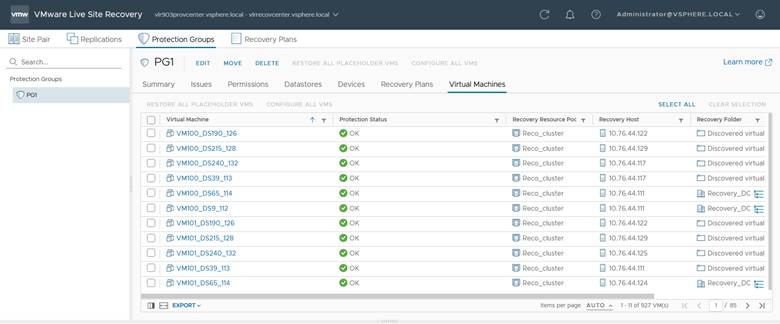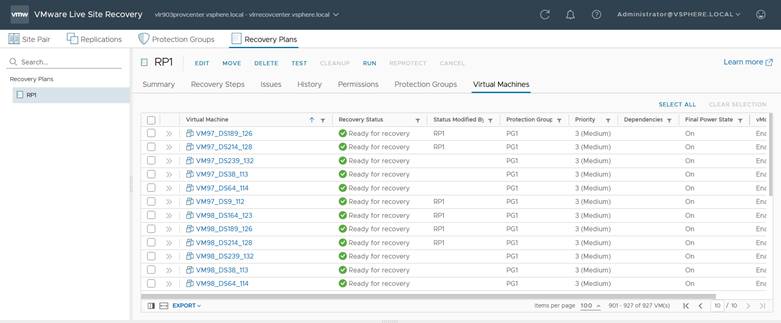Introduction
This blog presents a detailed overview of a large-scale VM migration involving 1,000 virtual machines using VMware vSphere 9.0, VMware Live Site Recovery (VLSR) 9.0.3, and Hitachi VSP One Block 20, implemented within a stretched storage cluster environment. The project highlights how advanced orchestration, robust replication, and highly available storage infrastructure can enable seamless workload mobility across geographically dispersed data centers.
By combining the automation and failover capabilities of VLSR with the high performance and redundancy of VSP One Block 20, this migration strategy demonstrates a resilient, scalable, and low-risk approach to enterprise VM mobility.
In today’s enterprise IT landscape, organizations are increasingly driven by the need to modernize infrastructure, consolidate data centers, and ensure uninterrupted service availability across geographies. Large-scale virtual machine (VM) migration becomes a critical enabler in these scenarios—whether due to mergers and acquisitions, hardware refresh cycles, cloud adoption strategies, or disaster recovery planning. Customers often face the challenge of relocating thousands of VMs without impacting business operations, risking data loss, or incurring extended downtime. Traditional migration methods fall short in scalability, automation, and resilience, making them unsuitable for enterprise workloads. Hitachi Virtual Storage Platform (VSP) systems with Global-Active Device (GAD) technology play a pivotal role in providing active-active data replication and zero data loss protection across sites, ensuring business continuity even during site-level failures. VMware Live Site Recovery (VLSR), in conjunction with the Hitachi Storage Replication Adapter (SRA), addresses these challenges by automating the recovery of virtual machines across sites with consistency, speed, and minimal manual intervention.
Infrastructure Architecture Overview
The diagram illustrates the end-to-end architecture supporting the large-scale VM migration between the protected site and the recovery site. At the protected site, 10 servers host 1,000 virtual machines, connected via Fibre Channel (FC) switches to the Hitachi VSP One Block primary storage system. The recovery site mirrors this setup with its own set of servers connected to the secondary VSP One Block system.
Hitachi Ops Center Protector is deployed on a dedicated protector server, with management handled through a central management server over IP network connectivity. Synchronous replication between primary and secondary storage is achieved using Global Active Device (GAD) pairs, with a quorum storage system providing arbitration for high availability. This configuration ensures real-time data consistency, high availability, and seamless failover capabilities across both sites.

Resources used in this environment:
· ESXi Host: Twenty servers, ten at each site equipped with dual-port Fibre Channel (FC) HBAs.
· Storage: Hitachi VSP One Block 20, serving as the primary and secondary storage and one Hitachi VSP array for Quorum device.
· Fibre Channel (FC) Switches: Two switches providing SAN connectivity to the datacenter storage network.
· Management Server: Centralized management of the vCenter servers and Protector VM.
Prerequisite
Before beginning the migration setup, ensure the following components are in place:
- VMware vSphere 9.0 environment with three vCenter instances for stretched configuration.
- VMware Live Site Recovery 9.0.3 installed and configured.
- Hitachi VSP One Block 20 arrays deployed at both sites for Primary and Secondary storage and one Hitachi VSP array for quorum device.
- Replication links established between Hitachi arrays using Global-Active Device (GAD).
- DNS resolution and time synchronization across all components.
Configuration steps
1. Storage Setup with Hitachi VSP One Block 20
- Create volumes on VSP One Block 20 and present them to ESXi hosts at primary.
- Configure GAD replication between Site A and Site B using Hitachi Ops Center.
2. VMware Site Pairing and Protection Groups
- In VMware Live Site Recovery, pair the two vCenter instances.
- Define protection groups for VMs.
- Assign recovery plans to each protection group, specifying target resources and priorities.


3. Network Mapping and IP Customization
- Map source and destination networks to ensure connectivity post-migration.
- Configure IP customization rules if IP changes are required during failover.
Refer to the implementation guide below for detailed instructions on performing configuration steps 1, 2, and 3.
https://www.hitachivantara.com/content/dam/hvac/pdfs/implementation-guide/configuring-srm-8-7-stretched-storage-certification-with-ops-center-protector-sra-5-0-1.pdf
4. Test Recovery Plan
- Run a test recovery plan to validate VM migration and application availability.
- Monitor storage replication status and VM boot sequence.
- Resolve any dependency or configuration issues identified during testing.

5. Execute Planned Migration
- Initiate a planned migration using Live Site Recovery.
- VMs are gracefully shut down at Site A and powered on at Site B.
Validation and Monitoring
- Use VMware LSR dashboards to monitor migration progress.
- Confirm storage replication status and volume accessibility from Site B.
Benefits
- Simplified orchestration of large-scale VM migrations
- Zero data loss with Hitachi GAD synchronous replication
- Reduced downtime and operational risk
- Enhanced disaster recovery readiness across sites
Conclusion
By leveraging VMware Live Site Recovery 9.0.3 and Hitachi VSP One Block 20 in a stretched cluster setup, organizations can achieve robust, scalable, and efficient VM mobility. Hitachi Global-Active Device (GAD) enables active-active data access between two storage systems across sites, ensuring zero data loss, continuous availability, and seamless failover in case of site outages. This solution ensures high availability and resilience for mission-critical workloads across geographically separated data centers.
#VSPOneBlock